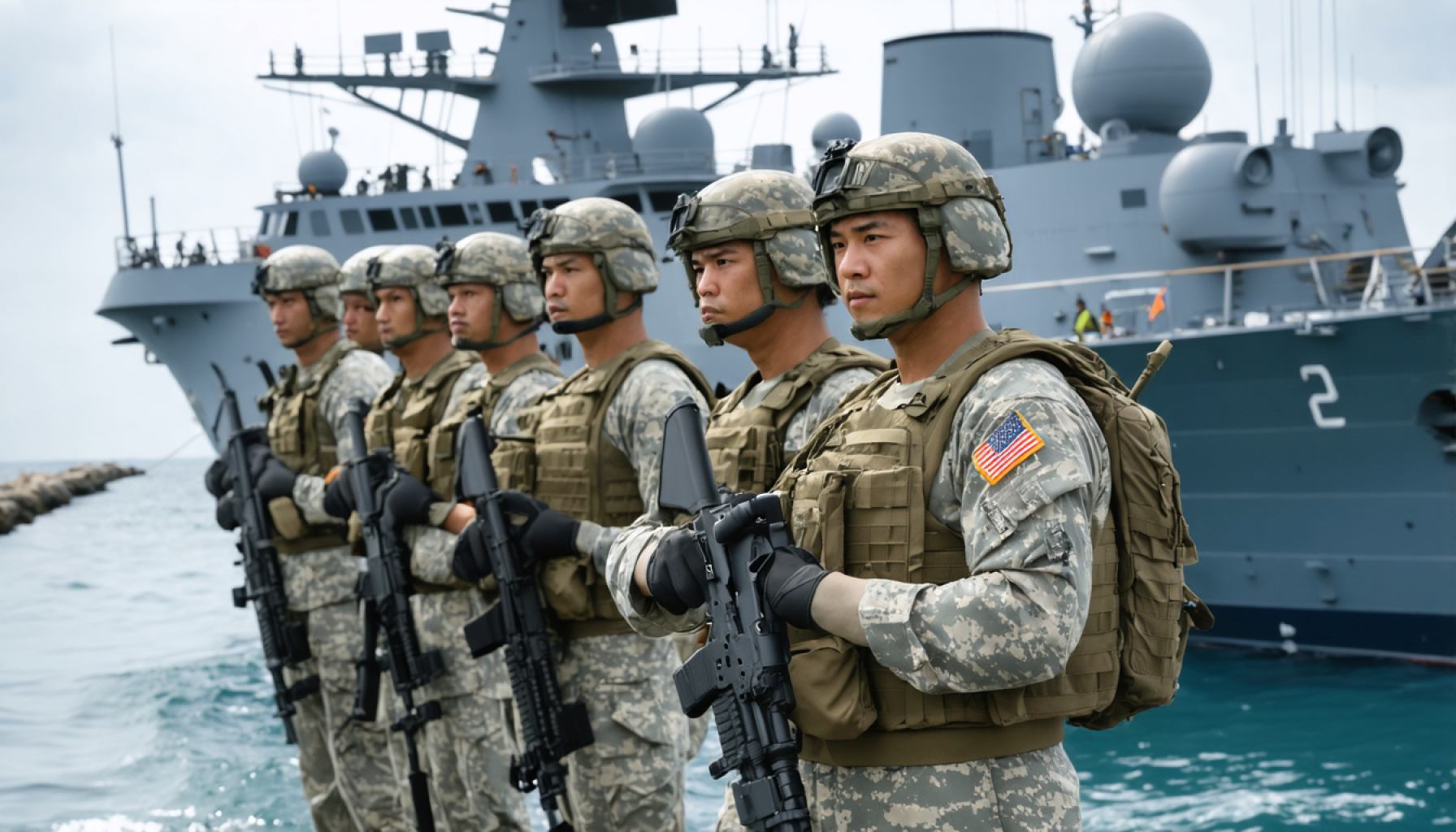- The U.S. has approved a $5.5 billion defense sale to the Philippines, including 20 F-16 fighter jets and advanced equipment.
- This sale strengthens the alliance between the U.S. and the Philippines against the backdrop of rising tensions in the South China Sea.
- The U.S. aims to counter China’s assertiveness by enhancing the Philippines’ military capabilities, particularly in air defense.
- The deal aligns with the U.S. strategy to focus defense efforts in the Asia-Pacific, amidst shifting geopolitical dynamics.
- U.S. Defense Secretary emphasized commitment to deterrence in the Indo-Pacific and support for the Philippines.
- The U.S.-Philippines defense partnership highlights shared values and a commitment to a free and open Indo-Pacific region.
- The arms sale is seen not just as a transaction but as a declaration of shared resolve for peace and stability.
Under the wide skies of Basa Air Base, the roar of an F-16 engine signals a new chapter in the enduring alliance between the Philippines and the United States. The U.S. has approved a significant defense sale to its Southeast Asian ally, pledging $5.5 billion worth of state-of-the-art fighter jets to bolster the Philippines’ military capabilities. As tensions simmer in the South China Sea, this move underscores a strategic pivot as Washington eyes Beijing’s growing assertiveness with cautious vigilance.
In a decisive gesture, the U.S. State Department greenlit the sale of 20 F-16 fighter jets along with advanced support equipment, marking a vital reinforcement to the Philippines’ defense strategy. This action aligns with America’s broader initiative to focus its defense resources towards the Asia-Pacific, a region teetering on the brink of geopolitical transformation. The timing is fitting—amidst rising territorial tussles with China, the Philippines stands as a steadfast bulwark of political stability and peace in Southeast Asia.
With Beijing’s expansive claims threatening to redraw maritime boundaries in the South China Sea, the U.S.-Philippines defense partnership is emerging as a fulcrum of resistance. This sale not only enhances the Philippine Air Force’s ability to patrol its vast maritime domains but also fortifies its capability to ward off aerial incursions. The presence of sophisticated F-16s is poised to amplify the country’s defense posture, making its airspace a redoubt against unwelcome encroachments.
The deal’s significance stretches beyond mere military optics—it embodies a renewed commitment to deterrence in the Indo-Pacific region. During a recent visit to Manila, Defense Secretary Pete Hegseth emphasized the U.S. resolve to confront “threats from the Communist Chinese,” reflecting a pivot from the prior U.S. administration’s rhetoric of allied “freeloading.” Now under a different leadership philosophy, the U.S. seeks to reassure the Philippines of its unwavering support, juxtaposed against a shifting global order.
The relentless dance of diplomacy and power in the South China Sea sees nations grappling with competing interests. Yet amidst these swirling tensions, the U.S.-Philippines alliance stands as a testament to shared values and a collective vision for a free and open Indo-Pacific. As fighter jets thunder across bases and skies, they do more than patrol—they herald a commitment to peace anchored in strength and unity. This arms sale, in the grand scheme of global affairs, is not just a transaction; it is a declaration. A declaration of shared resolve to keep the peace, one flight at a time.
Power Play: How the $5.5 Billion U.S.-Philippines Defense Deal Transforms Geopolitics
Overview
The recent U.S. approval of a $5.5 billion defense sale to the Philippines, featuring 20 F-16 fighter jets, marks a significant development in the geopolitical landscape of Southeast Asia. This move is pivotal, as it underscores the increasing strategic importance of the Indo-Pacific region amid rising tensions in the South China Sea and escalating U.S.-China rivalries. Here, we delve deeper into the implications, industry trends, and strategic advantages that accompany this substantial military commitment.
Strategic Implications
1. Strengthening Military Capabilities
– Enhancing Defense: The addition of F-16 fighter jets bolsters the defense capabilities of the Philippine Air Force, enabling enhanced patrolling and surveillance across its maritime zones. Sophisticated radar systems and modern avionics augment the overall defense strategy of Philippines.
– Deterrence Factor: With advanced weaponry and aerial capabilities, the Philippines can better deter potential aerial and maritime threats, contributing to regional stability.
2. Geopolitical Dynamics
– Countering China’s Assertiveness: The deal provides a counterbalance to China’s increasing influence and assertive territorial claims in the South China Sea. It reinforces the Philippines’ position as a key ally in the U.S.’s Indo-Pacific strategy.
– U.S.-Philippines Alliance: This arms sale reaffirms the robust military ties between the U.S. and the Philippines, serving as a bulwark against regional instability and showcasing a shared commitment to maintaining a rules-based order in maritime Southeast Asia.
Industry Trends and Market Forecasts
– Growing Defense Budgets: An upward trend in defense budgets is observed as nations prioritize military modernization to counter evolving threats. This increases demand for advanced fighter jets and integrated defense systems.
– Technological Advancements: Development of next-gen aircraft featuring stealth technology, enhanced maneuverability, and network-centric warfare capabilities remains a priority. Industry leaders like Lockheed Martin continue to innovate in these areas.
Pros and Cons Overview
– Pros:
– Improves national defense infrastructure and readiness.
– Strengthens international alliances and signifies global partnerships.
– Acts as a deterrent against potential aggressors.
– Cons:
– High financial burden on national budgets.
– Potential escalation in regional arms race.
– Risk of increasing military tensions in the region.
How-To: Optimizing Defense Resources
1. Integration and Training: Invest in training programs to leverage the full capabilities of new fighter jets. Establish joint training drills with U.S. forces to enhance interoperability.
2. Maintenance and Sustainability: Implement robust maintenance regimes to ensure aircraft longevity and operational readiness.
3. Collaborative Defense Planning: Engage in continuous dialogues with defense partners to adapt strategies according to evolving geopolitical scenarios.
Expert Insights and Predictions
– Sustainability in Defense: There’s a growing emphasis on sustainable defense practices, including resource-efficient technologies and reducing carbon footprints of military operations.
– Increased Regional Defense Cooperation: We anticipate increased collaboration among Southeast Asian nations to form collective security measures and share technological advancements.
Actionable Recommendations
– Immediate Training Initiatives: Begin immediate pilot training to maximize utilization of the F-16 fleet.
– Strengthening Diplomatic Channels: Utilize strengthened military capabilities as leverage in diplomatic negotiations to promote regional peace and security.
– Public Communication Strategy: Develop a clear communication strategy to inform and assure the public of the benefits and strategic necessity of such defense enhancements.
For more on geopolitical strategies and military advancements, visit the Department of Defense.
Conclusion
This arms deal serves as a vehicle for asserting strategic dominance in a rapidly transforming geopolitical landscape. As emerging defense dynamics unfold, nations must proactively engage in resource optimization, technological innovation, and strategic alliances to navigate the complex web of modern international relations effectively.







